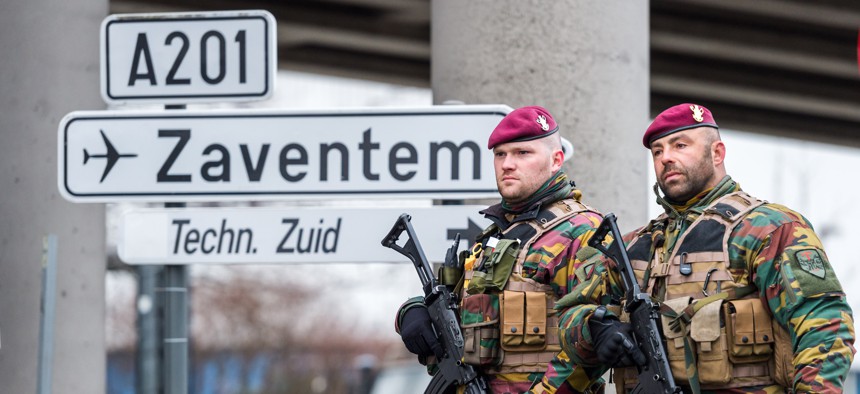
Belgian Army soldiers patrol at Zaventem Airport in Brussels on Wednesday, March 23, 2016. Geert Vanden Wijngaert/AP
ISIS Is Using the Media Against Itself
It doesn’t matter if the coverage that follows an attack is negative. For ISIS, any coverage is good coverage.
In the immediate aftermath of the attacks in Brussels on Tuesday, there was a period in which members of the Western news media were scouring for evidence of who might be behind them. Suspicion primarily fell on ISIS, which managed to pull off a complex, multi-target attack in Paris four months ago. Some speculated that the attackers were seeking revenge for Friday’s arrest in Brussels of Salah Abdeslam, a suspected logistics chief of the Paris attacks, and the last direct participant in those attacks believed to be at large. Others suggested, in my view correctly, that the attacks were not revenge-driven, but the outcome of months of careful planning.
Speculation about the ideological inclination of the perpetrators became certainty when, that afternoon, ISIS channels on Telegram, a social-media platform favored by jihadists, circulated an English-language claim of responsibility. The text, uploaded onto the Wordpress page of Amaq News Agency, ISIS’s “official” news wire, was instantaneously transferred across millions of computer screens and mobile phones by news outlets and commentators around the world.
So it was that ISIS commandeered the narrative space surrounding the attack, in spite of the fact that its statement provided no new information and, indeed, appeared to been an amalgamation of operational details already observed in Western media reports.
In the avalanche of uncertainty that followed the attacks, the ISIS propagandists were able to dictate their story—literally word for word—to an international, and specifically Western, audience. Releasing the claim of responsibility first in English was no mistake. Directed, first and foremost, at the Western enemies of ISIS, the statement was a way to capitalize on the international media storm surrounding Brussels that day. Be it through headlines or tweets, the propagandists manipulated a global audience, opponents and sympathizers alike, to disseminate their message of intimidation and enhance the perception of ISIS’s threat.
Read more: After Brussels, Will Voters Demand Foreign-Policy Experience?
Read more: How Facial Recognition Might Stop the Next Brussels
Read more: Flaws in Belgium’s Counterterrorism Efforts Were Long Known
The technique is not new. Indeed, modern-day terrorists have long embraced “propaganda of the deed,” a tactic that, in the words of the Australian Army information-operations specialist Jason Logue, involves ”planning and executing operations designed purely for their propaganda appeal.” However, ISIS understands the media like no other organization before it. It knows that, while territory and resources are crucial to the overall success of its aggressive insurgency in Syria and Iraq, the media is the arena within which the war of ideas is waged, where the group’s relevance—and, ultimately, its ideational longevity—can best be preserved and perhaps enhanced, even as it experiences territorial losses.
In recognition of this, ISIS has prioritized propaganda of the deed and, indeed, it seems to be getting better at executing it. Just hours after the first bombs exploded in Brussels, “official” ISIS propagandists were drip-feeding their information-hungry audience with a series of multilingual, multimedia claims that, while they seemed to be no more than simple rehashes of media reports, drowned out other voices. After the Paris attacks, these kinds of statements took nearly 15 hours to emerge. Tuesday, it took half that time.
In the past, the group has preferred to release snuff films as its primary vehicle for propaganda of the deed like this, be they of Mohammed “Jihadi John” Emwazi’s beheadings or the immolation of the Jordanian pilot Mu’adh al-Kasasbeh. However, as the media has grown steadily savvier and the consumer more desensitized, such films have apparently lost some of their ability to seize the global agenda. On the other hand, marauding terrorist attacks against the “Crusader” enemy in distant lands, while they may be infinitely more difficult to achieve, have not yet hit the point of diminishing returns in global attention. This likely means we can expect more.
In recent weeks, amid reports on territorial losses, leadership deaths, and the Abdeslam arrest, the theme of ISIS coverage in Western media has increasingly been one of “ISIS in decline.” Regardless of its veracity, the narrative of decline is not a healthy one for the organization. By pulling off operations like the Brussels attacks and then expertly capitalizing on the media storm that follows, ISIS can to some extent replace that narrative with one that conveys “ISIS in terrorist ascendancy.”
It doesn’t matter if the coverage that follows is negative—say, criticizing the group’s brutality or questioning its religious legitimacy. For ISIS, provided it’s on the propagandists’ terms and conveys the group’s purported strength and omnipresence, any coverage is good coverage.
In that sense, ISIS terrorism doesn’t end when a bomb detonates. Rather, it continues for hours, days, and weeks after, living on through the media.
As much as they seek to cause economic deadlock and political instability, operations like those in Brussels, Istanbul, Jakarta, and Paris are also pursued because they enable terrorists—be they followers of ISIS or al-Qaeda—to violently seize control of the media discourse and make a play for total information dominance. Hence, regardless of how much the ISIS leadership itself was involved in the actual planning of the attacks Tuesday—or whether the group is claiming a largely autonomous operation as its own, as it has in the past—it encourages events like them in large part so that its communications team can, as the insurgency scholar Neville Bolt puts it, use “the weight of the media against the media.” In this way, ISIS is killing in the name of air time—and it’s getting what it wants.



